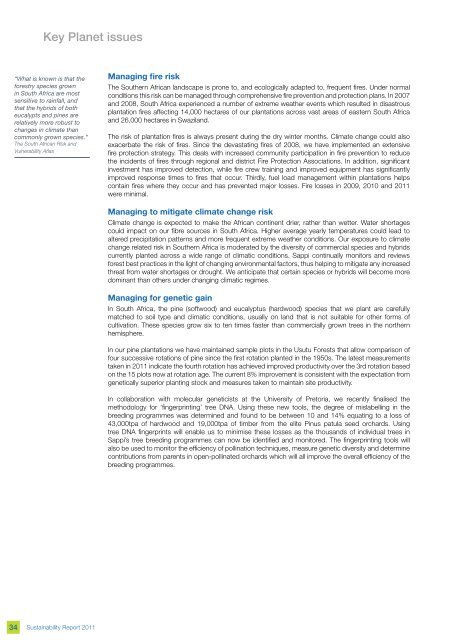Southern Africa - Sappi
Southern Africa - Sappi
Southern Africa - Sappi
You also want an ePaper? Increase the reach of your titles
YUMPU automatically turns print PDFs into web optimized ePapers that Google loves.
“What is known is that the<br />
forestry species grown<br />
in South <strong>Africa</strong> are most<br />
sensitive to rainfall, and<br />
that the hybrids of both<br />
eucalypts and pines are<br />
relatively more robust to<br />
changes in climate than<br />
commonly grown species.”<br />
The South <strong>Africa</strong>n Risk and<br />
Vulnerability Atlas<br />
34<br />
Key Planet issues<br />
Sustainability Report 2011<br />
Managing fire risk<br />
The <strong>Southern</strong> <strong>Africa</strong>n landscape is prone to, and ecologically adapted to, frequent fires. Under normal<br />
conditions this risk can be managed through comprehensive fire prevention and protection plans. In 2007<br />
and 2008, South <strong>Africa</strong> experienced a number of extreme weather events which resulted in disastrous<br />
plantation fires affecting 14,000 hectares of our plantations across vast areas of eastern South <strong>Africa</strong><br />
and 26,000 hectares in Swaziland.<br />
The risk of plantation fires is always present during the dry winter months. Climate change could also<br />
exacerbate the risk of fires. Since the devastating fires of 2008, we have implemented an extensive<br />
fire protection strategy. This deals with increased community participation in fire prevention to reduce<br />
the incidents of fires through regional and district Fire Protection Associations. In addition, significant<br />
investment has improved detection, while fire crew training and improved equipment has significantly<br />
improved response times to fires that occur. Thirdly, fuel load management within plantations helps<br />
contain fires where they occur and has prevented major losses. Fire losses in 2009, 2010 and 2011<br />
were minimal.<br />
Managing to mitigate climate change risk<br />
Climate change is expected to make the <strong>Africa</strong>n continent drier, rather than wetter. Water shortages<br />
could impact on our fibre sources in South <strong>Africa</strong>. Higher average yearly temperatures could lead to<br />
altered precipitation patterns and more frequent extreme weather conditions. Our exposure to climate<br />
change related risk in <strong>Southern</strong> <strong>Africa</strong> is moderated by the diversity of commercial species and hybrids<br />
currently planted across a wide range of climatic conditions. <strong>Sappi</strong> continually monitors and reviews<br />
forest best practices in the light of changing environmental factors, thus helping to mitigate any increased<br />
threat from water shortages or drought. We anticipate that certain species or hybrids will become more<br />
dominant than others under changing climatic regimes.<br />
Managing for genetic gain<br />
In South <strong>Africa</strong>, the pine (softwood) and eucalyptus (hardwood) species that we plant are carefully<br />
matched to soil type and climatic conditions, usually on land that is not suitable for other forms of<br />
cultivation. These species grow six to ten times faster than commercially grown trees in the northern<br />
hemisphere.<br />
In our pine plantations we have maintained sample plots in the Usutu Forests that allow comparison of<br />
four successive rotations of pine since the first rotation planted in the 1950s. The latest measurements<br />
taken in 2011 indicate the fourth rotation has achieved improved productivity over the 3rd rotation based<br />
on the 15 plots now at rotation age. The current 8% improvement is consistent with the expectation from<br />
genetically superior planting stock and measures taken to maintain site productivity.<br />
In collaboration with molecular geneticists at the University of Pretoria, we recently finalised the<br />
methodology for ‘fingerprinting’ tree DNA. Using these new tools, the degree of mislabelling in the<br />
breeding programmes was determined and found to be between 10 and 14% equating to a loss of<br />
43,000tpa of hardwood and 19,000tpa of timber from the elite Pinus patula seed orchards. Using<br />
tree DNA fingerprints will enable us to minimise these losses as the thousands of individual trees in<br />
<strong>Sappi</strong>’s tree breeding programmes can now be identified and monitored. The fingerprinting tools will<br />
also be used to monitor the efficiency of pollination techniques, measure genetic diversity and determine<br />
contributions from parents in open-pollinated orchards which will all improve the overall efficiency of the<br />
breeding programmes.

















